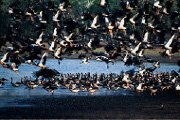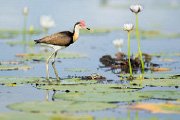Seasons
Kakadu has six different seasons, defined by the skies, rainfall, plants and animals.
You’re probably familiar with northern Australia’s two seasons: the dry season (April to October) and the wet tropical summer (November to March).
But Kakadu’s Traditional Owners recognise six different seasons based on thousands of years of local knowledge. The transitions between seasons are marked by subtle variations in the weather, the plants in flower and the bush foods that are most abundant.
Each season has different attractions for Kakadu visitors. Some areas of the park are closed by flooding during the tropical summer.
The seasons
Kudjewk – Monsoon season
December to March. 24°C – 34°C
This is the true tropical summer – thunderstorms, heavy rain and flooding.
Kudjewk’s heat and humidity cause an explosion of plant and animal life. Speargrass grows to over two metres tall and gives the woodlands a silvery-green hue.
Magpie geese nest in the wetlands while widespread flooding drives goannas, snakes and rats to seek refuge in the trees. Eggs and stranded animals are a good source of food for local Aboriginal people during this time.
Bangkerreng – ‘Knock ‘em down’ storm season
April. 23°C – 34°C
By April the rain clouds have dispersed and clear skies prevail. The vast expanses of floodwater recede and streams start to run clear again. Most of Kakadu’s plants are fruiting and its animals are caring for their young.
The early days of bangkerreng are marked by violent, windy storms that flatten the speargrass – these are called ‘knock ‘em down’ storms.
Yekke – Cooler (but still humid) season
May to mid-June. 21°C – 33°C
This is a relatively cool time with less humidity. Early-morning mists hang low over the plains and the shallow wetlands and billabongs are carpeted with water lilies.
Dry winds and flowering Darwin woollybutt tell local Aboriginal people that it’s time to start patch burning to ‘clean the Country’ and encourage new growth.
Wurrkeng – Cold weather season
Mid-June to mid-August. 17°C – 32°C
This is the cold time – at least by Northern Territory standards. Humidity is low, while daytime temperatures are around 30°C and drop to about 17°C at night.
Most creeks stop flowing in Wurrkeng and the floodplains quickly dry out. The Bininj/Mungguy continue patch burning, which is extinguished by the dew at night. Birds of prey patrol the fire lines during the day as insects and small animals escape the flames.
Magpie geese, fat and heavy after weeks of abundant food, crowd the shrinking billabongs with a myriad of other waterbirds.
Kurrung – Hot dry weather
Mid-August to mid-October. 23°C – 37°C
Kurrung is hot and dry. It is still ‘goose time’ but also time for local Aboriginal people to hunt file snakes and long-necked turtles.
Sea turtles lay their eggs on the sandy beaches of Field Island and West Alligator Head, where goannas sometimes rob the nests. White-breasted wood swallows arrive as the thunderclouds start to build.
Kunumeleng – Pre-monsoon storm season
Mid-October to late December. 24°C – 37°C
Kunumeleng is the pre-monsoon season, with hot weather that becomes increasingly humid. It can last from a few weeks to several months.
Thunderstorms build in the afternoons and showers bring green to the dry land. As the streams begin to run, acidic water from the floodplains can kill fish in billabongs with low oxygen levels. Barramundi move from the waterholes to the estuaries to breed, and waterbirds spread out with the increased surface water and plant growth.
Kunumeleng was when Aboriginal people traditionally moved camp from the floodplains to the Stone Country to shelter from the coming monsoon.
Want to find out more?
Discover the best times to visit Kakadu or check out our carefully crafted travel itineraries for all seasons.
Take the first step
A journey of 1000 miles begins with a single click.
Enter your email to get free trip planning advice from Kakadu rangers.





